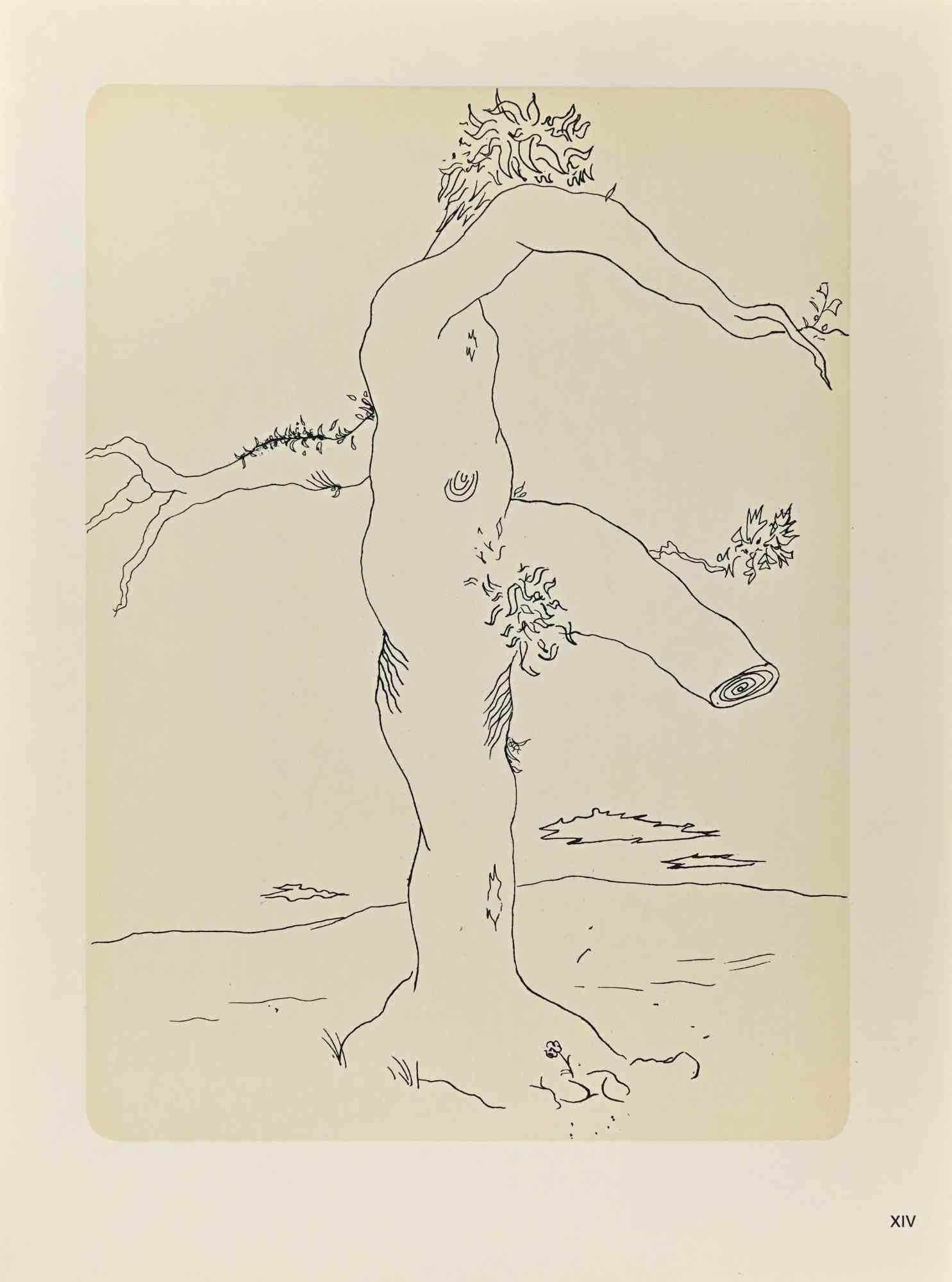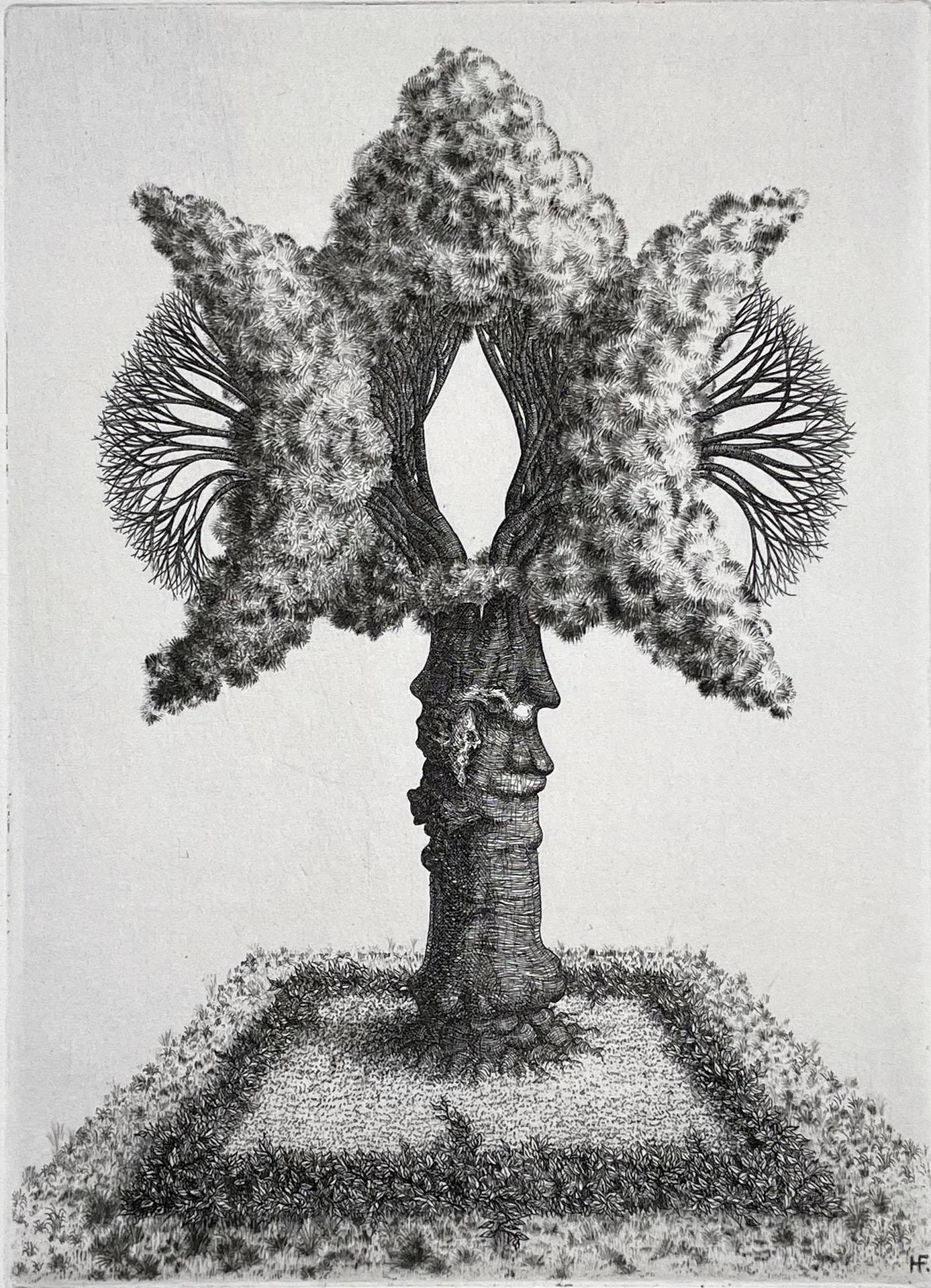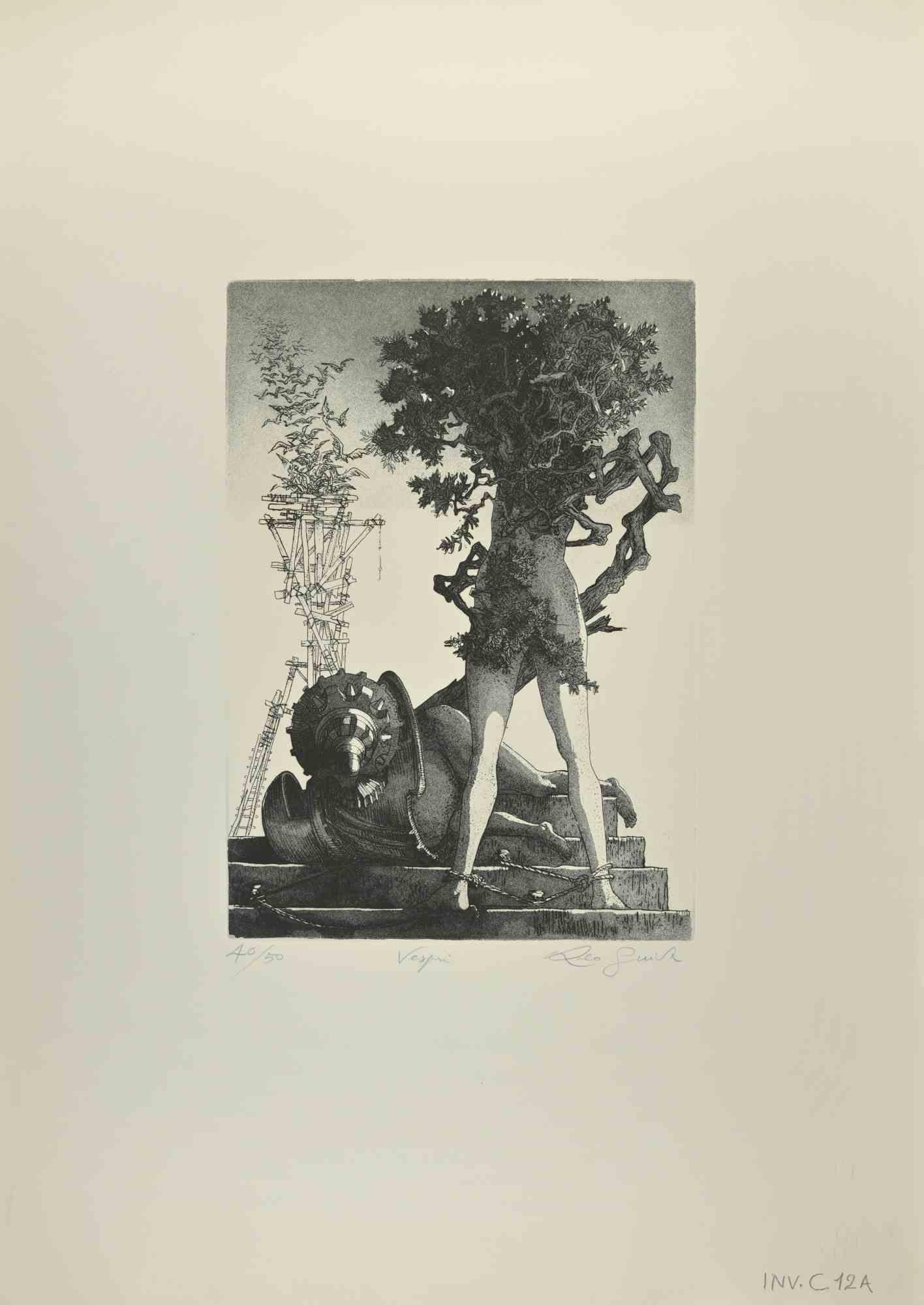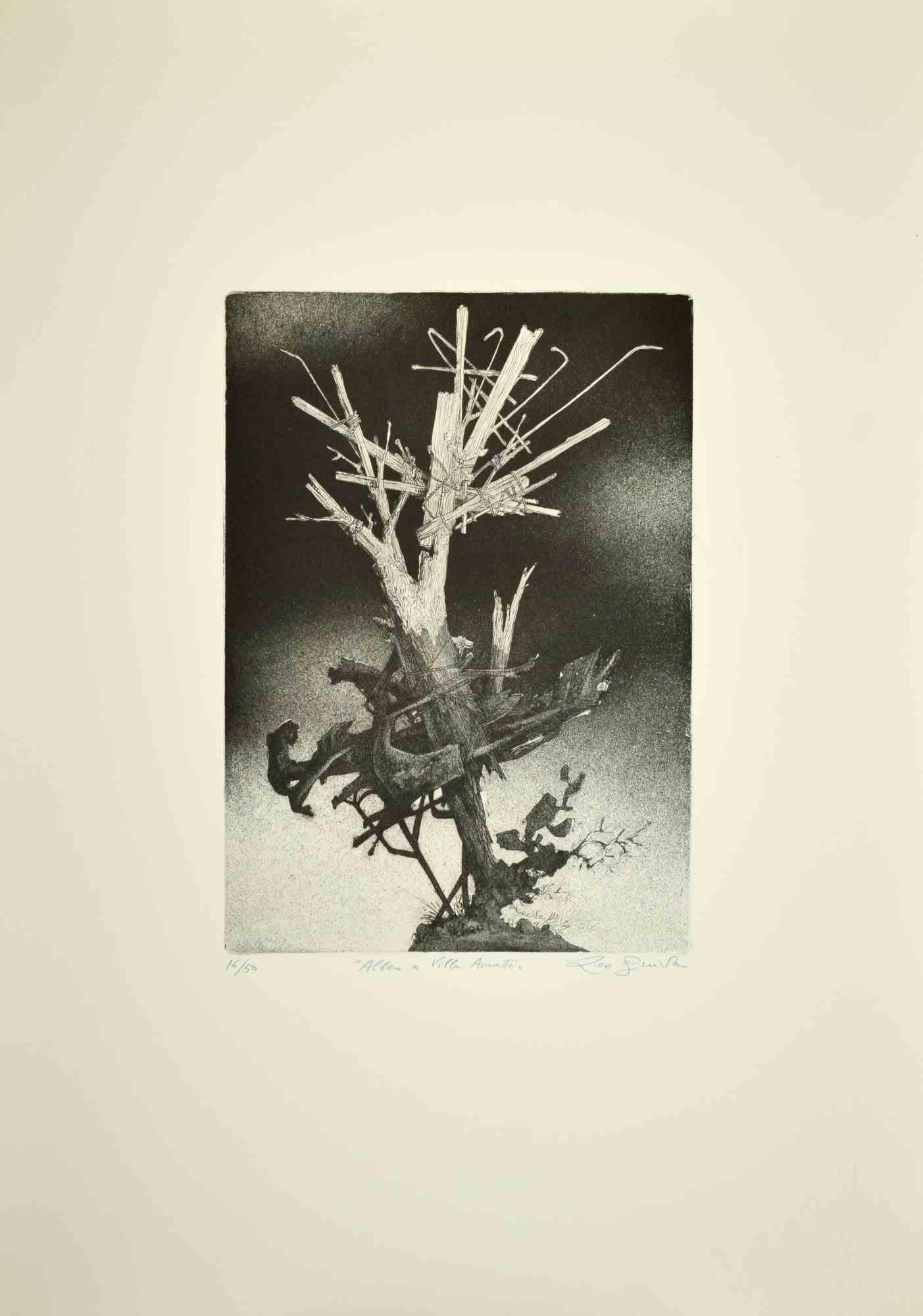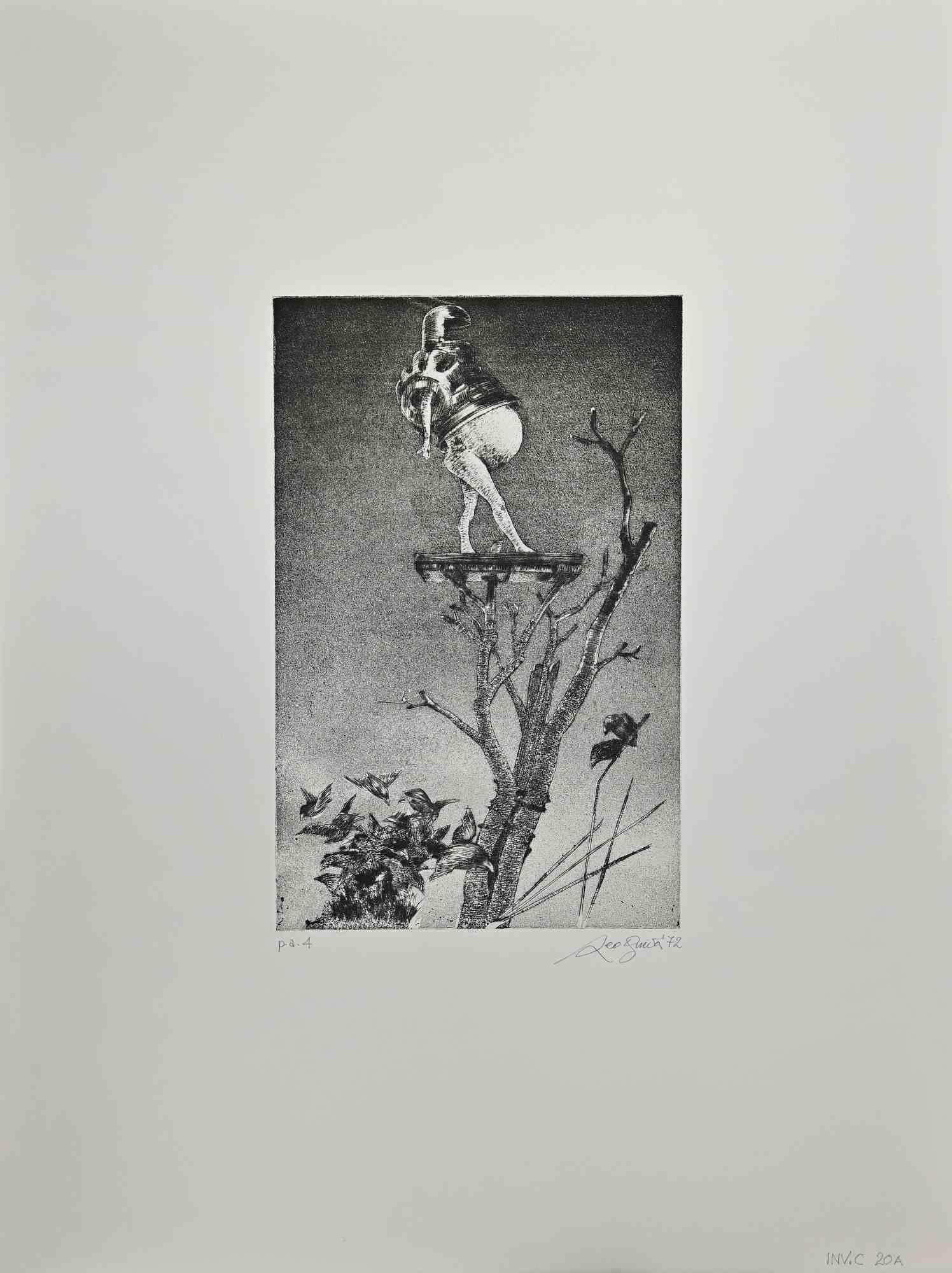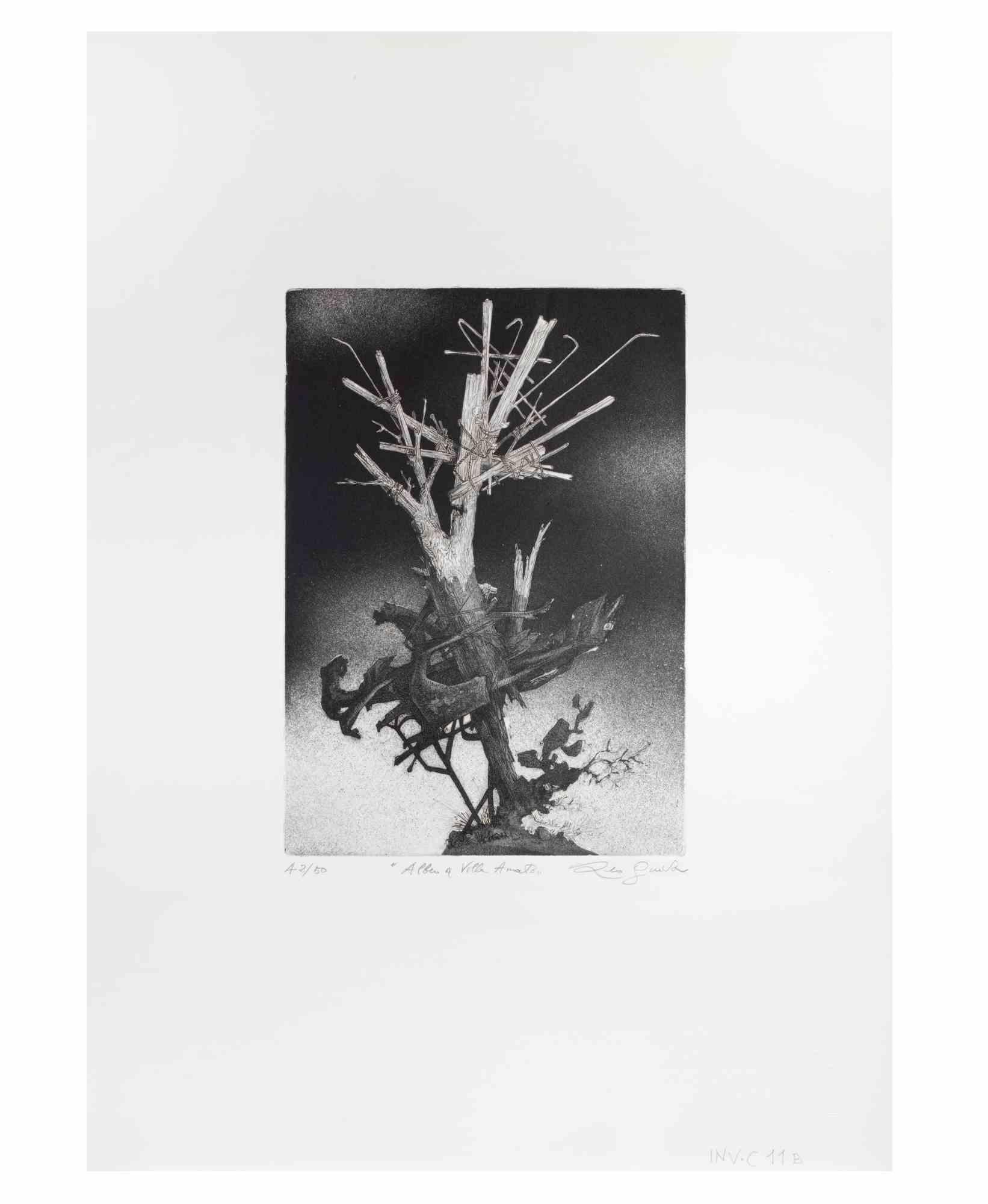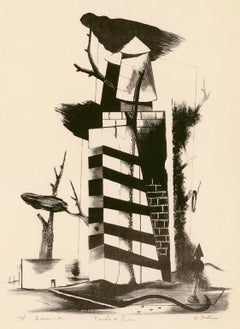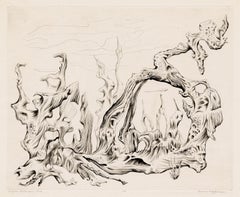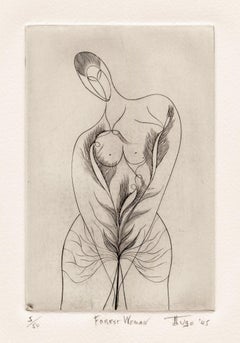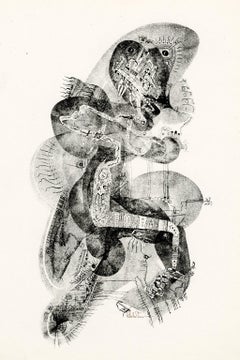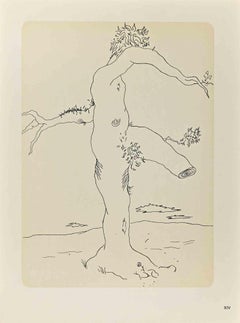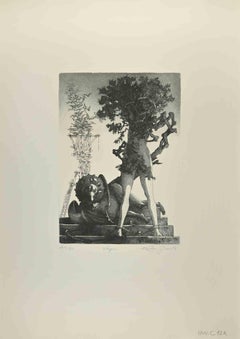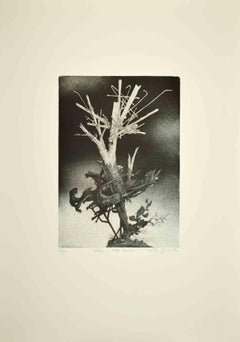Items Similar to 'Arbre-Homme' (Tree-Man) —Mid-Century European Surrealism
Want more images or videos?
Request additional images or videos from the seller
1 of 3
Ferdinand Springer'Arbre-Homme' (Tree-Man) —Mid-Century European Surrealism1945
1945
$1,400
£1,057.22
€1,210.42
CA$1,977.17
A$2,158.59
CHF 1,131.66
MX$26,216.93
NOK 14,132.61
SEK 13,344.95
DKK 9,034.53
About the Item
Ferdinand Springer, 'Arbre-Homme', engraving, 1945, edition 23. Signed and numbered '23/20' in pencil.
A fine, richly-inked impression, on heavy, buff wove paper, the full sheet with margins (2 1/2 to 4 1/8 inches), in excellent condition. Image size 10 11/16 x 7 3/16 inches; sheet size 17 7/8 x 12 1/2 inches. Matted to museum standards, unframed.
"... his painting has the simplicity, the diaphanous purity, the free curve, light-dark, unexpressed, inexpressible, and power also invites us to dream and to open the doors of mystery." —Bernard Dorival. Catalog of the retrospective "Ferdinand Springer", Museum of Fine Arts, Caen, France, 1973.
ABOUT THE ARTIST
Painter and printmaker Ferdinand Springer (1907-1998) was born in Berlin to a German father and a Swiss mother. After graduating from high school, he enrolled in art history studies at the University of Zurich. He began painting in 1927, visiting Milan, where he met Giorgio Morandi and Carlo Carrà. In 1928 he moved to Paris where he studied with Roger Bissière at the Académie Ranson. In the early 1930s, Springer worked and taught at Atelier 17 in Paris where he learned engraving from Stanley William Hayter. In 1937, he traveled to New York, where he exhibited at the Julian Levy Gallery and met Alexander Calder and Salvadore Dali. After moving to Grasse in southern France in 1939, he was interned by the Nazis, along with Max Ernst, Hans Bellmer, and Wols at the Tuilerie des Milles camp near Aix-en-Provence.
After his release in 1940, Springer returned to Grasse and started the “Grasse Group” with Hans Arp, Sonia Delaunay, Alberto Magnelli, and others. The war's escalation forced him to move to Switzerland, and much of his work from that period was lost. Springer re-launched his career in 1950 and, in 1960, he became a pioneer in the modern engraving revival with Pierre Courtin, Henri-Georges Adam, and Johnny Friedlaender.
I wanted to establish a relationship between the forms of my engravings and symbolic objects such as Cycladic idols, masks, totems, paintings on the bark of the Aborigines of Australia. It is the graphic transposition of the spirit of these magical, if not sacred, objects. " —Ferdinand Springer
In 1967 Springer was awarded the Chevalier des Arts et des Lettres by the French government, the same year that his first retrospective took place, in Heidelberg, Germany.
By 1975 he had settled permanently in Grasse, continuing to work and to exhibit throughout Europe and the United States.
Springer's work is included in the collections of the National Museum of Modern Art (Paris); the National Library (Paris); Museum of Fine Arts (Rouen); Museum of Modern Art (New York); Brooklyn Museum (New York), the Cincinnati Art Museum, Ohio; the Fogg Art Museum, Massachusetts; the LIbrary of Congress, Washington, D.C.; Yale University Print Collection (Connecticut); Mill College Library, California; California Palace of the Legion of Honor (San Francisco); Kunstmuseum Basel; Kunstmuseum (Bern); and Kunsthalle (Bremen).
"There is a moment in the life of a man, as in that of an era, when the circle closes, when everything comes together and when the synthesis is made... It is a moment when the artist manages not to work from nature, but naturally, in accordance with his inner and outer being. " -—Ferdinand Springer
- Creator:Ferdinand Springer (1907 - 1998, German)
- Creation Year:1945
- Dimensions:Height: 10.69 in (27.16 cm)Width: 7.19 in (18.27 cm)
- Medium:
- Movement & Style:
- Period:
- Condition:
- Gallery Location:Myrtle Beach, SC
- Reference Number:Seller: 1039951stDibs: LU53237685802
About the Seller
5.0
Recognized Seller
These prestigious sellers are industry leaders and represent the highest echelon for item quality and design.
Platinum Seller
Premium sellers with a 4.7+ rating and 24-hour response times
Established in 1995
1stDibs seller since 2016
321 sales on 1stDibs
Typical response time: 1 hour
Associations
International Fine Print Dealers Association
- ShippingRetrieving quote...Shipping from: Myrtle Beach, SC
- Return Policy
Authenticity Guarantee
In the unlikely event there’s an issue with an item’s authenticity, contact us within 1 year for a full refund. DetailsMoney-Back Guarantee
If your item is not as described, is damaged in transit, or does not arrive, contact us within 7 days for a full refund. Details24-Hour Cancellation
You have a 24-hour grace period in which to reconsider your purchase, with no questions asked.Vetted Professional Sellers
Our world-class sellers must adhere to strict standards for service and quality, maintaining the integrity of our listings.Price-Match Guarantee
If you find that a seller listed the same item for a lower price elsewhere, we’ll match it.Trusted Global Delivery
Our best-in-class carrier network provides specialized shipping options worldwide, including custom delivery.More From This Seller
View AllTanks & Trees — Mid-century American Surrealism
Located in Myrtle Beach, SC
Karl Eugene Fortess, 'Tanks & Trees', lithograph, c. 1940, edition 100. Signed, titled, and numbered '100/P' in pencil. Inscribed 'For Usui - K.' in the bottom left margin. A fine, richly-inked impression, on cream wove paper, with full margins (1 1/2 to 2 1/2 inches); a slight crease across the top right sheet corner, well away from the image; otherwise in excellent condition. Image size 13 1/8 x 10 inches; sheet size 17 3/8 x 13 3/16 inches. Matted to museum standards, unframed.
Provenance: Estate of Francis Pratt.
Francis and her husband Bumpei Usui...
Category
1940s Surrealist Figurative Prints
Materials
Lithograph
'European Landscape' —Mid-century American Surrealism
By Lawrence Kupferman
Located in Myrtle Beach, SC
Lawrence Kupferman, 'European Landscape', drypoint, edition 50, 1942. Signed, dated, titled, and numbered '7/50' in pencil. A superb, finely nuanced impression, on cream wove paper; the full sheet with margins (1 to 1 3/4 inches); in excellent condition.
Image size 10 7/8 x 13 3/8 inches; sheet size 13 1/8 x 16 1/2 inches. Archivally matted to museum standards, unframed.
An impression of this work is included in the permanent collection of the Syracuse University Art Museum.
ABOUT THE ARTIST
Lawrence Kupferman (1909 - 1982) was born in the Dorchester neighborhood of Boston and grew up in a working-class family. He attended the Boston Latin School and participated in the high school art program at the Museum of Fine Arts, Boston. In the late 1920s, he studied drawing under Philip Leslie Hale at the Museum School—an experience he called 'stultifying and repressive'. In 1932 he transferred to the Massachusetts College of Art, where he first met his wife, the artist Ruth Cobb. He returned briefly to the Museum School in 1946 to study with the influential expressionist German-American painter Karl Zerbe.
Kupferman held various jobs while pursuing his artistic career, including two years as a security guard at the Museum of Fine Arts, Boston. During the 1930s he worked as a drypoint etcher for the Federal Art Project, creating architectural drawings in a formally realistic style—these works are held in the collections of the Fogg Museum and the Smithsonian American Art Museum. In the 1940s he began incorporating more expressionistic forms into his paintings as he became progressively more concerned with abstraction. In 1946 he began spending summers in Provincetown, Massachusetts, where he met and was influenced by Mark Rothko, Hans Hofmann, Jackson Pollock, and other abstract painters. At about the same time he began exhibiting his work at the Boris Mirski Gallery in Boston.
In 1948, Kupferman was at the center of a controversy involving hundreds of Boston-area artists. In February of that year, the Boston Institute of Modern Art issued a manifesto titled 'Modern Art and the American Public' decrying 'the excesses of modern art,' and announced that it was changing its name to the Institute of Contemporary Art (ICA). The poorly conceived statement, intended to distinguish Boston's art scene from that of New York, was widely perceived as an attack on modernism. In protest, Boston artists such as Karl Zerbe, Jack Levine, and David Aronson formed the 'Modern Artists Group' and organized a mass meeting. On March 21, 300 artists, students, and other supporters met at the Old South Meeting House and demanded that the ICA retract its statement. Kupferman chaired the meeting and read this statement to the press:
“The recent manifesto of the Institute is a fatuous declaration which misinforms and misleads the public concerning the integrity and intention of the modern artist. By arrogating to itself the privilege of telling the artists what art should be, the Institute runs counter to the original purposes of this organization whose function was to encourage and to assimilate contemporary innovation.”
The other speakers were Karl Knaths...
Category
1940s Surrealist Abstract Prints
Materials
Drypoint
'Forest Woman' — Mid-Century Surrealism, Atelier 17
Located in Myrtle Beach, SC
Ian Hugo, 'Forest Woman', engraving, 1945, edition 50. Signed, dated, titled, and numbered '5/50' in pencil. With the blind stamp 'madeleine-claude jobrack E...
Category
1940s Surrealist Figurative Prints
Materials
Engraving
'Going My Way?' — Mid-century American Surrealism
By Robert Vale Faro
Located in Myrtle Beach, SC
Robert Vale Faro, 'Going My Way?', lithograph, 1946, edition 14. Signed in pen, recto. Titled, numbered '#118 14/14' and dated '5/5/46' in pen, verso. A fine, richly-inked impression, on heavy, off-white wove paper, with full margins (1 5/8 to 2 15/16 inches), in excellent condition. Image size 13 1/8 x 7 3/8 inches; sheet size 17 x 12 3/8 inches. Scarce. Matted to museum standards, unframed.
An impression of this work is in the permanent collection of the National Gallery of Art.
ABOUT THE ARTIST
Robert Vale Faro (1902-1988) was a modernist architect and artist associated with the Chicago Bauhaus. He received his degree in architecture and design from the Armour Institute in Chicago and worked at L'Ecole des Beaux-Arts, Paris, from 1924-27, where he was influenced by Harry Kurt Bieg and Le Corbusier. Upon his return to Chicago, Faro worked with the important modernist Chicago architects George and William Keck under Louis Sullivan.
Faro founded the avant-garde printmaking group Vanguard in 1945. The group counted Atelier 17 artists Stanley William Hayter, Sue Fuller...
Category
1940s American Modern Abstract Prints
Materials
Lithograph
Le Cheval (The Horse) — Mid-Century Cubism
By Léopold Survage
Located in Myrtle Beach, SC
Léopold Survage, 'Le Cheval' (The Horse), color etching, edition 60, 1953. Signed and numbered '46/60' in pencil. Initialed in the plate, lower right. A superb, richly-inked impressi...
Category
1950s Surrealist Figurative Prints
Materials
Etching
'Petrouchka's Predicament' — Mid-century American Surrealism
By Robert Vale Faro
Located in Myrtle Beach, SC
Robert Vale Faro, 'Petrouchka's Predicament', color lithograph, 1946, edition 20. Signed, dated, titled, and numbered '115' and '14/20' in pen. A fine, richly-inked impression, with fresh colors, on heavy, off-white wove paper; full margins (1 1/4 to 2 1/2 inches), in excellent condition. Image size 21 3/4 x 13 3/4 inches; sheet size 24 3/4 x 16 1/4 inches. Scarce. Matted to museum standards, unframed.
'Petrouchka', a ballet with music by the Russian composer Igor Stravinsky and choreography by Michel Fokine, is based on the legend of Russian folklore. 'Petrouchka', a puppet made of straw with a bag of sawdust as his body, comes to life and has the capacity to love, a story conceptually resembling that of Pinocchio.
ABOUT THE ARTIST
Robert Vale Faro (1902-1988) was a well-known modernist architect and artist associated with the Chicago Bauhaus. He received his degree in architecture and design from the Armour Institute in Chicago and worked at L'Ecole des Beaux-Arts, Paris, from 1924-27, where he was influenced by Harry Kurt Bieg and Le Corbusier. Upon his return to Chicago, Faro worked with the important modernist Chicago architects George and William Keck under Louis Sullivan.
Faro founded the avant-garde printmaking group Vanguard in 1945. The group counted Atelier 17 artists Stanley William Hayter, Sue Fuller...
Category
1940s American Modern Abstract Prints
Materials
Lithograph
You May Also Like
Tree-Man - Phototype print by Latis - 1970s
Located in Roma, IT
Tree- Man is a print on cream-colored paper, realized by Latis (Emmanuel Peillet) in the 1970s.
Phototype print. Good conditions
The artwork realized through deft and precise stroke...
Category
1970s Modern Figurative Prints
Materials
Paper
Arbre sans titre, by Francois Houtin
By François Houtin
Located in Palm Springs, CA
Signed, titled and numbered in pencil, 3/50. Imaginary topiary and garden scene, with incredibly fine line work in the etching.
François Houtin was born in Craon en Mayenne, France...
Category
1970s Contemporary Landscape Prints
Materials
Etching
Woman-Tree - Etching by Leo Guida - 1970s
By Leo Guida
Located in Roma, IT
Woman- Tree is an Etching realized by Leo Guida in 1970s.
Hand-signed by the artist with pencil on the lower margin, numbered, edition of 40/50 prints.
Good condition.
Artist sens...
Category
1970s Contemporary Figurative Prints
Materials
Etching
The Tree at Villa - Etching by Leo Guida - 1972
By Leo Guida
Located in Roma, IT
The Tree at Villa is an artwork realized by the Contemporary Italian artist Leo Guida (1992 - 2017) in the 1970s.
Black and white etching on paper.
Hand Signed on the lower righ...
Category
1970s Contemporary Figurative Prints
Materials
Etching
Man on a Tree - Etching by Leo Guida - 1972
By Leo Guida
Located in Roma, IT
Man on a tree is an etching realized by Leo Guida, in 1972.
Hand-signed and dated on the left lower margin, Leo Guida 72' , p.a.4 Inv. C20 A.
64X48 cm.
Good Conditions.
Leo ...
Category
1970s Contemporary Figurative Prints
Materials
Etching
The Tree at Villa - Etching by Leo Guida - 1970s
By Leo Guida
Located in Roma, IT
The Tree at Villa is an artwork realized by the Contemporary Italian artist Leo Guida (1992 - 2017) in the 1970s.
Original black and white etching on paper.
Hand Signed on the low...
Category
1970s Contemporary Figurative Prints
Materials
Etching
More Ways To Browse
Keith Haring Untitled D
Large Erte
Large Signed Picasso Prints
Le Blanc Seing
Leger Hand Signed Lithograph
Leonard H Mersky
Leroy Neiman Americas Cup
Leroy Neiman Silkscreens
Leroy Neiman Skier
Leroy Neiman Stud Poker
Leroy Neiman Vegas
Lichtenstein Crak
Lichtenstein Mermaid
Lord Leighton Photogravure
Luigi Rossini On Sale
Magritte Victoire
Malcolm Myers
Malleus Maleficarum
